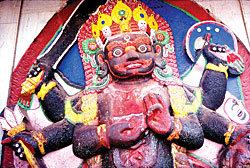 |
The practice of mother worship is probably pre-Aryan and has co-existed with the tradition of ancestor worship since hunter-gatherer times. In South India, Amma, the mother, is the guardian of most villages. Jai Bhawani used to be the war cry of Marathas just as Bengalis went to war shouting Jai Durge, and the ferocious Kali was worshipped by the warriors of Central India. The enduring appeal of Sati, the mother eternal, has been the distinctive mark of Hinduism in the mountainous regions between Assam and Kashmir. In Mithila, the mother is Bhairavi, the deity of decay who sets the stage for renewal.
In all her forms, the goddess is the embodiment of cosmic energy. She is Shakti, the Supreme Power. Worship of the Mother Goddess is often laden with Tantric rituals. Considering the complexity involved in appeasing female deities, worshipping Shiva is a lot simpler.
Shivaratri has a decent claim to being the national festival of the country, the presiding deity being none other than the Lord of Animals. Indra and Vishnu, too, have been venerated in the Kathmandu Valley since the time of the Lichhavis. Indrajatra itself marks the day when the forces of Prithvi Narayan Shah vanquished the unprepared warriors of the last Malla king of Kathmandu. The Gorkha court could have easily ordained that their day of victory be marked with festivities. But somehow Dasain established itself as the main socio-religious festival of Nepal.
There are many stories explaining the significance of Dasain. According to Ramayan legends, Rama sought the blessing of Durga to defeat the demon-king Ravana. In another narrative of the triumph of good over evil, Mahisashurmardini trounces an animal demon to free the earth from its excesses. These are interesting stories, but not everyone who celebrates Dasain knows much about them. For most Nepalis, Dasain is the festival and that's it.
In Bengal, the beginning of Durga Puja festivities is dated to the early seventeenth century. The Mysore Dushera too is believed to have begun around the time the Mughal Empire was disintegrating but the East India Company was yet to establish itself. Dasain ensconsced itself as the festival of choice of warrior kings in different regions of south Asia, including in many mountain principalities that were to later become parts of Nepal.
Present forms of Dasain festivities in the country are probably of more recent origin. They may have evolved in the barracks of Gorkha regiments where Brahmin priests simplified complex rituals of Shakti worship to suit the temperament of Matwali soldiers. They sanctified eating, drinking, gambling and making merry, all in the name of the Mother Goddess. Shah and Rana rulers merely institutionalised the system back home.
Ironically, those who gave Dasain pan-Nepal acceptability - the Janjatis of the mid-mountains from the east and west - have begun to call for its boycott. In keeping with the Urdu-laden Gorkha Bhasha and the lack of official caste hierarchy within the British and Indian Gurkhas, the lahures kept the faith through their own secular celebrations of religious festivities such as Dasain and Tihar. Thus they kept in touch with the idea of Nepal and Nepalis rather than their own ethnic particularities. As long as these indefatigable fighters continue to serve abroad, Dasain celebrations there will retain their secular character. It may not be politically correct to say so in these times, but Dasain is indeed the 'national' festival of Nepal, and it has an international face.



